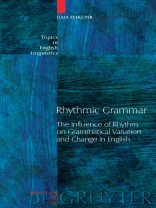This groundbreaking book highlights a phonological preference, the Principle of Rhythmic Alternation, as a factor in grammatical variation and change in English from the early modern period to the present. Though frequently overlooked in earlier research, the phonetically motivated avoidance of adjacent stresses is shown to exert an influence on a wide variety of phenomena in morphology and syntax.
Based on in-depth analyses of extensive electronic databases, the book presents 20 exemplary studies from different structural categories. Among them are much-debated as well as novel issues, including the double comparative worser, ‘predicative only’ a- adjectives, variant past participles, the placement of the degree modifier quite, the order of conjuncts in binomials, the negation of attributive adjectives and sentence adverbs, variable adverbial marking, the use or omission of the infinitive marker, and the a- prefix before – ing forms. The studies provide qualitative and quantitative evidence of the importance of rhythmic alternation in synchronic variation as well as diachronic change, without neglecting interactions with a set of competing functional tendencies. Thus, the book contributes essential aspects to the description and explanation of the phenomena considered, calling for a fundamental revision of current thinking about the interface between phonology and morphosyntax. In addition, the empirical findings are brought to bear on theoretical discussions of more general interest, yielding a critical assessment of the merits and limitations of two nonmodular linguistic theories: Optimality Theory and spreading activation models. The latter type is developed into a comprehensive conception integrating functional factors such as the Principle of Rhythmic Alternation in an overarching framework for language variation and change.
The wide range of subject areas covered makes the volume essential reading and a source of inspiration for linguists with interests as diverse as the phonology-morphosyntax interface, English grammar, the history of English, functional linguistics, Optimality Theory, as well as neuro- and psycholinguistics.
Table of Content
Chapter 1 Introduction
1.1. The state of the art
1.2. Aims and scope
1.3. The structure of the argument
Chapter 2 The Principle of Rhythmic Alternation introduced
2.1. Outline
2.1.1. The universality of rhythmic organization
2.1.2. Isochrony types: stress timing vs. syllable timing
2.1.3. Compensation strategies
2.1.4. Functional explanations for rhythmic alternation
2.2. Previous research on rhythmic influences on English grammar
Chapter 3 Methodology
3.1. Corpora and their limitations
3.2. The phonology of written language
3.3. Concordance software and search procedures
3.4. Tests of statistical significance
Chapter 4 Analysis of attributive structures
4.1. Introduction
4.2. Worse vs. worser from EMod E to nineteenth-century English
4.3. A-adjectives in PDE
4.4. Mono- and disyllabic variants of past participles
4.4.1. Drunk vs. drunken from ME to PDE
4.4.2. Broke vs. broken from ME to PDE
4.4.3. Struck vs. stricken from ME to PDE
4.4.4. Knit vs. knitted from ME to PDE
4.4.5. Lit vs. lighted from ME to PDE
4.4.6. Summary
4.5. A quite vs. quite a from EMod E to PDE
4.6. The order of coordinated colour adjectives in PDE
4.7. Negated attributive adjectives in PDE
4.8. Summary
Chapter 5 Analysis of verbal and adverbial structures
5.1. Introduction
5.2. Negated sentence adverbs in PDE
5.3. Suffixed and suffixless adverbs
5.3.1. Quick vs. quickly from EMod E to PDE
5.3.2. Slow vs. slowly from EMod E to PDE
5.3.3. Scarce vs. scarcely in PDE
5.4. Marked and unmarked infinitives
5.4.1. Infinitives dependent on active make in Emod E and LMod E
5.4.2. Infinitives dependent on passive make from Emod E to nineteenth-century English
5.4.3. Infinitives dependent on passive bid in nineteenth-century English
5.4.4. Infinitives dependent on the marginal modal dare from EMod E to PDE
5.5. A-prefixation of -ing-forms
5.5.1. A-prefixation of -ing-forms following set from EMod E to PDE
5.5.2. A-prefixation of -ing-forms following go from EMod E to PDE
5.6. Summary
Chapter 6 Theoretical implications
6.1. Introduction
6.2. Optimality Theory
6.2.1. Universal, violable and ranked constraints
6.2.2. A critique of Optimality Theory
6.2.3. OT approaches to language variation and change
6.3. Spreading activation models
6.3.1. Principles of neural action
6.3.2. Networks in production and perception
6.3.3. Implications of the alternation of activation and recovery
6.3.4. Interactivity between levels
6.3.5. Limits to interactivity
6.3.6. Language variation and change in a neuro- and psycholinguistic perspective
6.3.7. Limitations of interactive activation models
Chapter 7 Conclusion
7.1. Synopsis
7.2. Outlook
About the author
Julia Schlüter is Post-doctoral Research Fellow at the Universität Paderborn, Germany.












